Non-Theme Set Pieces & Selected Through Content
SET PIECE 6-1: Sho-cart
The introduction of the drivable track cart could be considered through content; certainly most of the time spent on the cart in chapter 8 is just that. Its introduction, however, is a self-contained section with a clear beginning and end, and it definitely lasts long enough to be a set piece. It doesn�t fit with any other theme, but I think the designers did a good job finishing this set piece with a bang.



None of the enemies along the length of the track are a real threat, because their ability to target Freeman while he moves at cart-speed is limited. Because the area around the track is wide open, however, it�s easy enough to fire at and kill them, however. The memorable thing about this set piece is that it does have a clear end�when Freeman is catapulted into the air at the end, and flies a hundred feet onto a distant platform. This is obviously self-contained, it definitely qualifies as extended content.
SET PIECE 6-2: Tentacles
This odd boss encounter plays with numerous videogame conventions, especially those found in the boss fights of Quake and Quake 2. The encounter is clearly a boss fight, but the player cannot directly attack the enemy. There are encounters in Quake like this, in the sense that some bosses were effectively immune to gunfire, but nothing in Quake ever approached the level of elaborateness (or made the player so vulnerable) as this encounter. At best, the Quake encounters of this type simply forced the player to solve a very small puzzle, whereas this boss fight manages to involve the exploration of an entire level. The player has to pass through the chamber housing the tentacles at least three times, although only the first pass is really interesting. The tentacles attack loud sounds, meaning that regular running and jumping is extremely dangerous. This would make only for a moderate challenge, as there is a sneak function and it works here, but the designers throw in a clever problem to solve. An exit and a ladder are blocked by destructible crates.
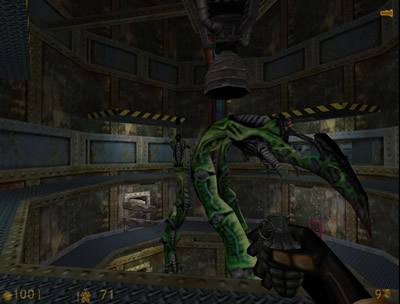
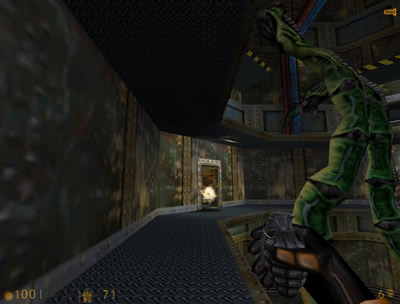
This forces the player to take a risk, which is always good. It also demonstrates the finer points of the noise-seeking mechanic to the player, showing them exactly how to use the grenades to distract the beast. Killing the creature is an unremarkable event that involves merely pressing a button�but sneaking past it is an elegantly designed task. My only real complaint with the sneaking is that it can take a long time because it�s not clear what level of noise is dangerous, and the passage by the creature has to be repeated one time too many. The first two times through are good for building tension, but too much repetition just becomes frustrating. If the player overlooks some part of the puzzles beyond, or gets lost, this hurdle becomes annoying in a way that doesn�t add anything to the game.
SET PIECE 7-4: Gargantua
This fight is similar to the encounter with the tentacles, in that the player has to pass by it several times before defeating the boss, and that the player has to defeat the enemy through means other than a weapon. Like the tentacles, the Gargantua demonstrates its abilities on NPCs.
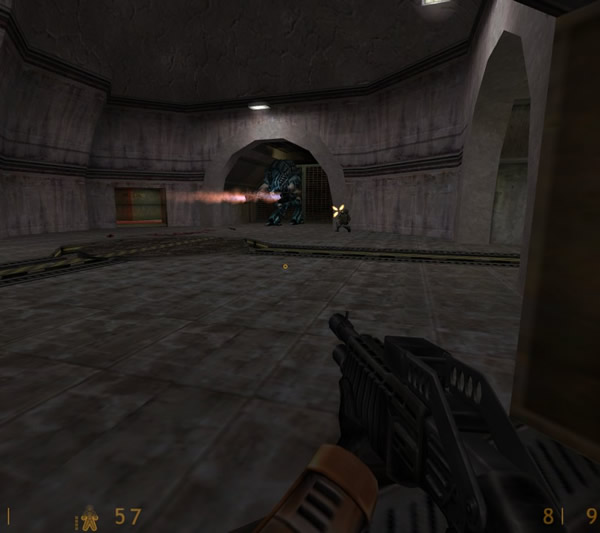
After reactivating the generator, the player has to cross this room again and race the Gargantua to the electrical nodes. This already presents a huge problem. How does the player know where to go, and if they explored the back room where the power nodes are, how are they supposed to get back out after being trapped by the pursuing Gargantua? The footrace itself is exciting and a nice break from the slow progression through cover-based content. The destination is the problem.
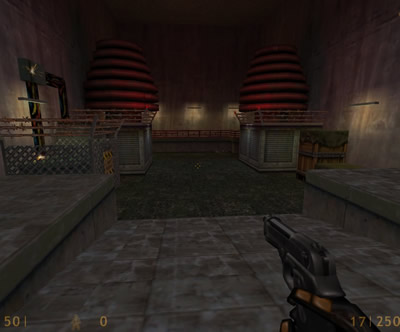
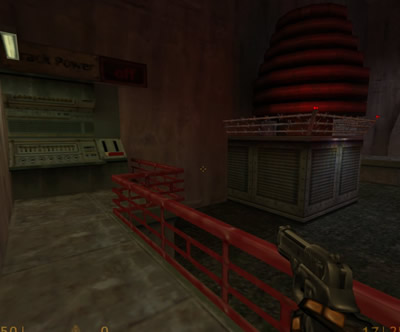
There�s no lighting or decals visible from this angle to tell the player where to go. Highlighting the path, even subtly, wouldn�t have broken the tension here. The switch that the player is supposed to reach isn�t especially clear, either. Moving slowly, a player should figure out that the walkway leads to a switch, but players are going to be panicking here, and might miss it the first two times. This is a low-skill boss fight, and after two or three deaths, unsuccesful players will realize they�re just missing something that�s supposed to be obvious. The thrill of a fight like this should be in nailing it the first or second time, while the feeling of fear is still palpable, and not after the player has become bored with trying to find a switch.
SET PIECE 12-12: Charge of the Vortigaunts
This set piece is a fantastic example of the "reward-by-fun" principle. Chapter 12 is full of difficult set pieces, but the purpose of this one is to give the player something mindlessly fun to do after trudging through the brutal encounters that precede it. The setup is simple: there's a floor-mounted rifle with infinite ammo pointing up a ramp full of Vortigaunts.


After the initial wave, the Vortigaunts teleport in one or two at a time, making it easy to target them one by one. Really, this is like a carnival shooting gallery. The point is not for this to be hard, but to relieve some of the tension that has been building through all of the intense (and deadly) set pieces that surround this one.
SET PIECE 12-14: Marked for Death
This set piece, although it doesn't fit into any particular theme, is one of Half-Life's most idiosyncratic moments. There are some curious design decisions here from the perspective of overall game difficulty. The set piece begins with a chase similar to the one in set piece 7-4; a Gargantua pursues Freeman to a device that allows him to kill it. The first strange thing is that this chase is actually a lot easier than its obvious ancestor. The Gargantua will become sidetracked by various enemy soldiers and obstructing cars. The set piece gets interesting once Freeman makes it to the artillery station at the end.

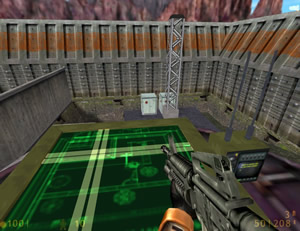
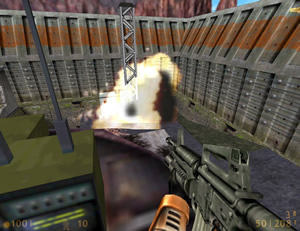
The interface for controlling the artillery is easy to use and the splash radius of its impact make it powerful (and fun). So what's the point of this set piece? Where's the challenge? The challenge is not the point. Chapter 12, since it is sufficiently hard already, doesn't require a grand challenge at the end. This is another example of reward-by-fun. I find it a little unusual that there are two such set pieces so close together. I will say, however, that chapter 12 of Half-Life is one of the most densely-packed levels in any game that I have ever played, and so I suppose its insistence on breaking the tension with puzzles and other unusual content makes sense.
SET PIECE 17-2: Second-Hand Violence
This set piece recalls both set piece 12-14 and 7-4, in that Freeman has to flee from a chasing Gargantua. Like many things in the Xen portion of the game, it's poorly done as compared to what came before. The chase itself is rather short, and quite abrupt.
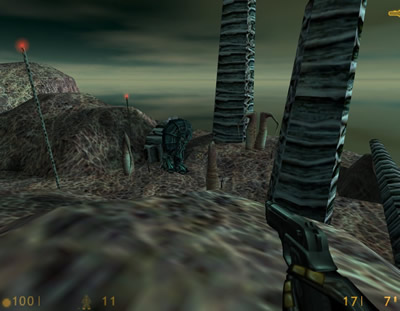
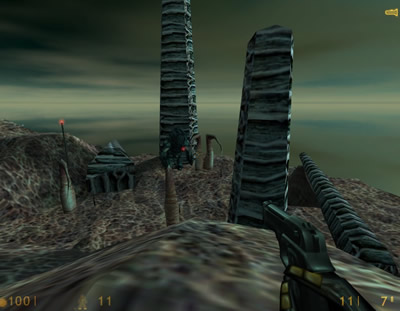
In addition to being short, the goal of the chase is nebulous. First-time players are going to have no idea what they're supposed to do out in the environment seen above. The essential idea is the same as in both of the previous set pieces; the player has to use the environment to kill the Gargantua. But how is the player supposed to figure out that it's the tentacles that are the mechanism for killing it? How are they supposed to figure out a good place to stand? Set piece 7-4 had a similar problem, in that it wasn't obvious that the generator was the mechanism for killing the Gargantua. Even there, however, there was only one button to press, and there wasn't a large empty space to confuse the player. And finally, shooting the tentacles to kill the creature takes an unnecessarily long and boring time. Confusion can be useful in game design, but only sparingly, and not like this. Boredom is to be avoided.
Selected Through Content
What happens in between set pieces? Half-Life is not a series of set pieces lined up one after another with no breaks; often there are significant amounts of content in between set pieces which do not possess the defining properties of a set piece. I call these portions of the game through content. To understand what through content is and how it works, we're going to glance back at the history of videogame design for a moment. As game design history moved from the composite era into the set piece era, and the set piece replaced the challenge, designers began to need something to replace composite flow. Instead of bouncing back and forth between genres to keep up a good "rhythm" for the game and keep players interested without over-taxing them, the designers of set piece games needed to do something else. Generally this meant that set piece games returned to the up-and-down motion along the axis of obstacles we originally saw in the arcade era. There are some differences between what we see in the arcade and set piece eras, however. The through content portions of Half-Life and later set piece games tend to have a much shallower difficulty curve relative to the steadily increasing difficulty one would expect from sequential challenges in a videogame.

There is more to through content than just a low level of difficulty. Through content is also essentially the opposite of everything that defines a set piece. Through content is usually made up of brief actions; even if there are multiple tasks made up of through content between set pieces, they tend to be varied qualitatively rather than quantitatively. That is, the player may have to perform three different tasks between set pieces, but all three will be of roughly equal difficulty and each will be a different kinds of task. For example, in between set pieces 7-2 and 7-3, there is a generator puzzle with a few different kinds of enemies mixed in.


Although the player has to face several types of enemies and solve a puzzle, the difficulty in each of these rooms never really grows. (Interestingly, the Houndeye enemy seen here is almost exclusively used in through content. This seems to indicate that the set piece/through content model of gameplay might be a natural property of games made the way Half-Life was made.) With this in mind, we can set out three guidelines for through content as it appears in Half-Life.
- Through content exists at a fraction of the difficulty of the set pieces it punctuates. As set pieces get harder, the through content gets harder as well, but its difficulty does not scale with nearby set pieces. Its level of difficulty is in place to break tension, not add to or reiterate it.
- Through content does not scale in length with the set pieces it punctuates. The longest set pieces are not broken up by the longest through content. If anything, the reverse seems to be true.
- Although through content may consist of many small tasks between set pieces, each of those tasks is short and tends to be qualitatively varied.
We're going to take a look at how Half-Life uses through content in certain spots in the game. This won't cover every single example of through content in the game, but the best examples contain real lessons, and we'll see what they can teach us about game design.
Moving Up and Down
The Right Monster for the Job
One of the observations that most clearly supports the set piece/through content division is that there are enemies which almost exclusively appear in small, short challenges. It would be a tautology to say that through content monsters appear only in through content, but I think the evidence in Half-Life speaks for itself in this regard. The Houndeye and Headcrab zombie rarely appear except in the shortest encounters. With a few exceptions, zombies come in groups of one or two. They move slowly and, except when they have the element of surprise, rarely present much of a threat.



If the designers are looking for a task which can punctuate set pieces to relieve tension or simply alter the pace of a level, zombies are perfect for that.
What is true of the Zombie is largely true of the Houndeye as well, although there are some significant differences between the two types of enemies. The Houndeye is less durable than the Headcrab zombie, but it also tends to come in packs and is much faster than the zombie. The speed and numbers mean that the Houndeye might actually damage players who are paying attention. Even on the hardest difficulty setting, however, they don�t inflict that much damage when they do strike. Instead, we see Houndeyes appearing in spots that might otherwise have been just a little too boring. Unremarkable corridors and catwalks which wouldn�t be appropriate for a full set piece are the habitat of the Houndeye.



Like the zombie, the Houndeye largely disappears at the climax of the cover theme.
Almost, But Not Quite
The presence of Houndeyes or Zombies frequently means that the designers planned a section as through content, but the presence of enemies like marines or Vortigaunts does not necessarily mean that a bit of content is a set piece. The primary criterion for a set piece, especially in Half-Life, is the �extended� aspect of content. Speed-runners may be able to blow through a set piece in a few seconds, but otherwise it tends to take around a minute or more (to say nothing of deaths and re-attempts) to get through a set piece. The appearance of the more challenging enemies does not, by itself, create an extended content situation; the context has to be right, too. Thus, there are many examples of a few enemies arranged to be dispatched quickly. The best example of this is the scattered marines at the end of chapter 8.

One grenade will take out these clustered marines, and the player is fairly well-stocked at this point in the game. The important thing about this set piece is how it serves the game�s pacing. Chapter 8 is full of long, crowded set pieces and has a huge amount of slow, cart-based through content. The designers, realizing this, allow the player to blow through a few quick encounters by positioning small groups of marines in locations that don�t have a lot of cover. It�s almost like an example of comic relief in a drama in that it refreshes the viewers/players so that they can fully appreciate the upcoming content.
The above is an example of what I call �almost-but-not-quite set pieces,� which serve as variations in difficulty and pace in between set pieces. Another good borderline case is in chapter 12, in which the player encounters a group of combating aliens and marines. Unlike other set pieces in which the fighting between the factions creates an arena dynamic, however, the fighting here just reduces each side to virtually nothing.


No matter who survives, a few Snarks or grenades will end the action more or less immediately, so I don�t think this passes the �extended� content measure. Freeman�s involvement in the battle is extremely limited, unless the player deliberately interrupts the fighting between factions.
I think the most fascinating property of these �almost� set pieces is that they often do a better job breaking the tension than a complete absence of danger would do. In the composite era, designers bounced between genres to break the tension and/or monotony of one genre�s challenges slowly getting harder across a game. Half-Life does this, too, because it�s not a pure set piece game�it�s also a composite game. Half-Life�s platformer content often breaks up the most intense sequences in the game, as we have seen many times. Set piece games go up and down in difficulty to accomplish something similar. It�s interesting, though, that the designers of this game felt that relieving the tension around especially hard set pieces required especially flashy through content. In chapter 12, there�s a good example of this.

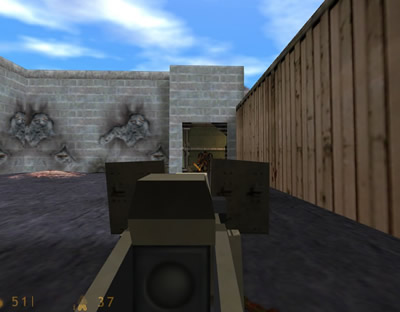
The player fights a pair of soldiers and then has to blow open a door using a high-explosive cannon. Out of that door, numerous alien grunts come charging (which requires a special script because charging is not normal for them) for the player to pick off. Much like in set piece 12-11, the player has to simply gun them down with the enhanced firepower. This example is much shorter, and so doesn�t really pass the extended criterion, so it makes more sense to see it as part of a chain of through content. The goal is the same as that of its set piece counterpart, though: it�s a reward-by fun.
Another good example of this is the two mostly oblivious marines in chapter 5. For most of the game, sneaking up on a marine is quite difficult and requires knowing where that marine is located ahead of time. Veteran players can sometimes get the drop on a marine by shooting a few exposed pixels of the marine�s knee, foot or helmet from around a corner. New players, who don�t know where to expect enemies, can�t really do this, except at this one juncture.
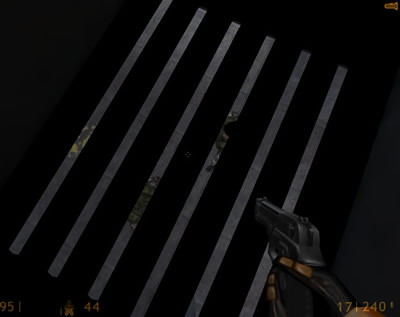
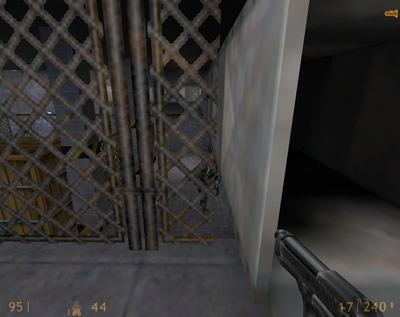
Sneaking around the ducts to get the right angle to blow these two to pieces takes some time, but because the player isn�t really in danger and there�s no clear beginning or end (the player doesn�t have to kill them) it doesn�t really resemble a set piece. It�s just another almost-set piece which breaks up a long string of more intense content with something just a little bit different and, if we can term a simulated double-murder so, something that�s just silly fun.
Moving Side to Side: Assorted Platformer Content
One of the things I already wrote about in the platformer theme is that the role of platformer content in Half-Life is to break up the otherwise endless series of shooter set pieces. I also mentioned that the platformer content doesn�t really fit the definition of a set piece, because it lacks the self-containment aspect of one. Nevertheless, it made sense to look at many examples of the longer platformer sections as set pieces to understand how they related to one another, and how they fit into the game as a whole. There are many platformer challenges which did not fit into that theme because they were so short, and I want to take a look at some of them here. Ultimately, most of these are no different than their longer counterparts in terms of design or purpose.
The best example of platforming to relieve tension is chapter 10, because the whole thing is based around platformer content, breaking up several shooter-heavy chapters. The second best example is in chapter 6. Chapter 6 is built around a boss (the tentacles) that exists in its literal and metaphorical center. Surrounding that boss is a larger amount of platformer content.
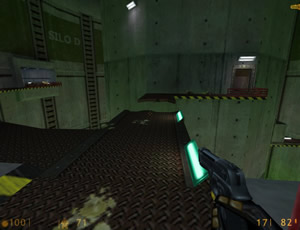
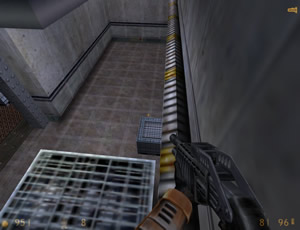
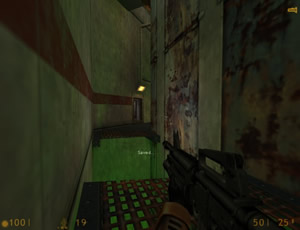
Sneaking past the tentacles might be the tensest moment in the entire game because of how exposed Freeman is. All of the content around it, by contrast, is made up of small encounters with isolated monsters and jumping tasks. Whether it�s jumping over a broken catwalk or jumping on top of wall fixtures to get past radioactive/electrified puddles, the tasks are relatively simple. The tentacles encounter is tense, slow and fearful, but it�s not particularly complex. The long chains of through content are not especially challenging, either; they�re designed to counteract the creeping tension of facing the instant-death drama of the tentacle room.
Not every bit of platformer through content is placed so well, though. Context is important for through content because of what the placement of different types of content can say to the player. For example, at the beginning of chapter 8, there is an optional excursion into a corridor with a flooded room that requires some very precise jumps.
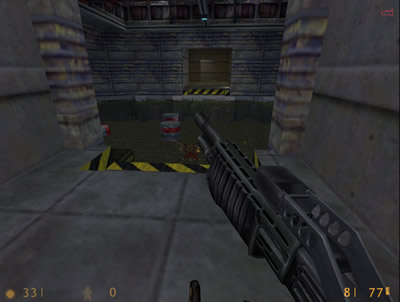
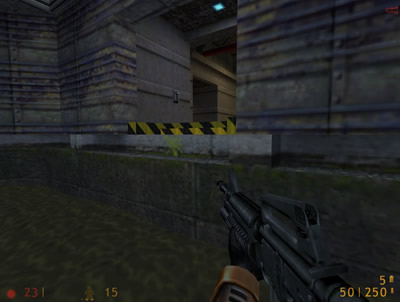
The second jump pictured here might have the smallest margin of error in the game. The penalty for failure is nothing, but there�s also no great reward for completing it�there�s no Easter egg or giant ammo cache. The fact that this content comes at the beginning of the chapter makes it seem like chapter 8 is going to be much more maze-like than it actually is. In reality, there are really only three places in the whole chapter that require any change of course. (In my opinion, that�s three too many, but I understand that the designers didn�t want the chapters to all feel the same.) First-time players can easily be misled by this sideshow because it comes first in the chapter�before the player gets a proper introduction to what this chapter is really about. The content itself is only mildly problematic, but it�s in the wrong spot. It doesn�t break up anything; it just gives a strange impression of the chapter to come.
Chapter 8 does actually have some good platformer content, although it doesn�t resemble platformer content at first glance. There are two brief sections on the cart in which the player has to drive through some low-hanging boxes that swing by.
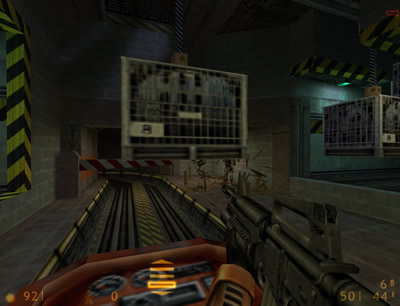
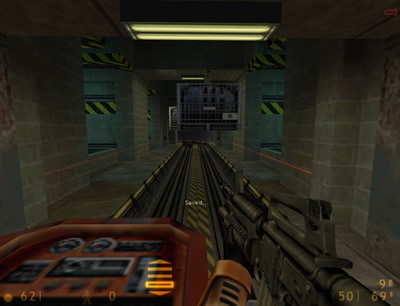
Slowing down or ducking at the right time is the key to avoiding being knocked off the cart. This is actually a form of entirely orthodox platformer content. The boxes that swing past are just periodic enemies that knock Freeman off of platforms (in this case, the cart). This doesn�t involve jumping, but precisely timed movement is a big part of the platformer form too. In the first instance of this, it�s not difficult at all, and the player can simply duck for the entire pass. The second instance is a classic evolution of the first, in which new elements are overlaid on top of the original elements to increase the danger. The lasers mean that if the player gets knocked off the cart, turrets will activate. The addition of two marines means that the player can�t just crouch the whole way through, or Freeman won�t have a way to fire on them. Thus, the player has to quickly react and kill the marines without getting hit in the head by one of the moving boxes. It�s short, but it�s a good example of composite design styles appearing in platformer content in the middle of the game to break up long strings of set piece content.
Dramatic Flourishes
As a part of the research for this book, I asked many people what they remembered about Half-Life. Most of the answers had nothing to do with the big battles, boss fights, weapons or mechanics. Rather, the things that stuck out in the memories of the most nostalgic players were the cinematic flourishes with which the game is filled. These moments were what made it seem like Half-Life had a great �story.� I put the word story in quotes because I don�t believe that Half-Life had a good story in the conventional sense of the word, but I agree that there are many moments in the game which have a certain artistic flair to them. A good example of this, and one that I heard about often from other players, is the section in chapter 12 where two marines shoot holes in the air duct where Freeman is hiding.
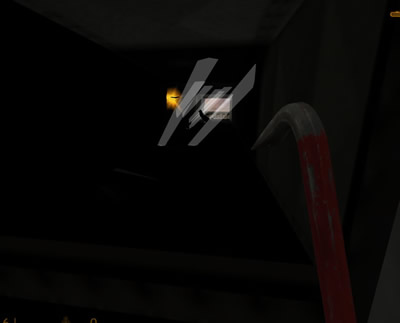
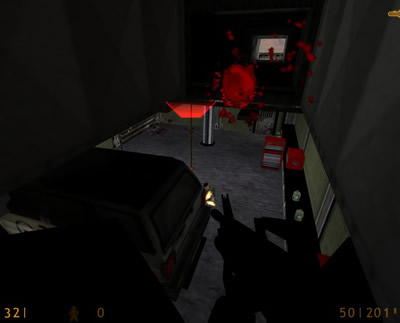
The marines detect Freeman (ostensibly) when he bashes the vent screen in and alerts them with the sound. The marines shoot the duct full of holes, and then it crashes to the ground. The actual game design causes and results of this event are far different than what the player believes them to be, however. I don�t have access to the game code, but I do know from other set pieces that much of what happens here is not a product of intrinsic enemy AI. Instead, what�s probably happening is that when Freeman crosses a certain line in the duct, a custom AI script tells the enemies to shoot the duct. This may not even actually happen, either; the player can�t see the enemies, and the angle of the bullets doesn�t really match the position of the marines once they are visible. It may be that an invisible, custom-generated actor fires the bullets and then de-spawns. This is a convenient trick used in many games across many genres. What�s more, the duct here can be shot through, while in the rest of the game this is impossible. (Try shooting through solid duct floors! Freeman can�t do it.) So we know that the designer had to ask the programmers to create a special object that was permeable to bullets. Finally, the designer also had to ask the artists and programmers to create the beams of light which poke through those bullet holes, because the lighting engine of Half-Life does not support this kind of streaming light anywhere else in the game, as any trip through any other lit drainage pipe or duct will reveal.
I don�t know how much time these pieces of content took to make. What I do know is that the level-editor which the Valve designers were using would have required several modifications and unique objects to make this happen. It�s obvious that the Valve team put a lot of effort into moments like these, even if the return on investment was low in terms of minutes of gameplay. This series of scripts takes all of five seconds to play out, whereas a set piece which can be created by a level designer all on his or her own might last five minutes. The ratio of minutes of manpower to gameplay is much higher in a set piece because so much of the work is done ahead of time in the form of the level editor. We�ll take a look at several of the best brief moments of content throughout the game and how they are put together.
Outrunning the Fireball
If we take the notion of a cinematic moment as being something that has happened in movies before it happened in videogames, this bit of through content is the most cinematic set piece of the whole game. Just as the player is about to guide Freeman out of a pipe in chapter 12, a lone marine tosses a satchel charge into the pipe. I remember reviews of Half-Life from the late 90s and early 2000s mentioning this moment as a way of praising the AI of Half-Life. This isn�t an example of AI in the conventional sense, though. A one-time script tells the marine to drop the satchel when Freeman crosses a certain point in the pipe.
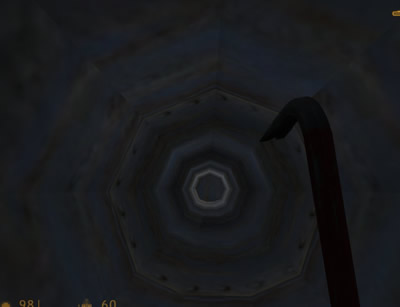
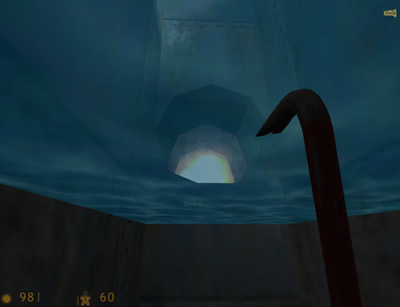
The satchel is not actually that dangerous; its blast radius is fixed and its explosive power is not conserved inside the small space of the tube. A real explosion might have its force redirected out the other end of the tube, resulting in the kind of �outrun the fireball� moment the designers were trying to recapture. The physics of Half-Life don�t support this, however, and so the designers had to simulate the effect. To do this, they set up several flame jets that had a special �shoot through walls� property, although this was probably the only special asset/programmer request involved in this event. Each of these flame jets was timed to progress as marked on the diagram. The �explosion� isn�t really an explosion at all, but rather a series of heat sources (like the flame jets in chapter 10) activating in sequence.
Turbofan
The giant fan in chapter 6 is a memorable moment and a good example of an important property in videogames. The player�s task is to turn on the fan and then get above its rotating blades before they start moving too fast to pass.
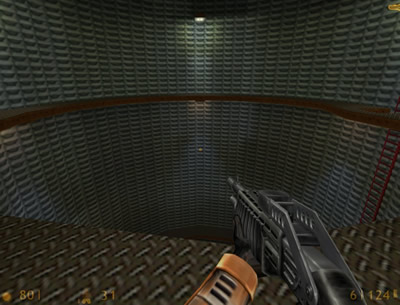
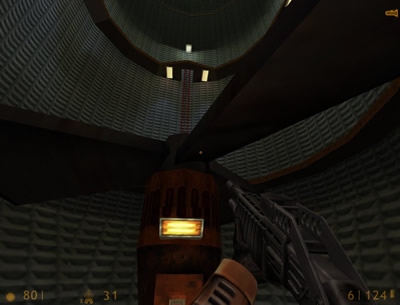
Succeeding at this will result in the player flying up into a boarded up ceiling, and flying is a lot of fun. Setting aside the plausibility of this flight, there are two major violations of physics here. The first violation is that the pressure difference above and below the fan would cause Freeman to get sucked up into the blades if the player waits too long to get him out, but that does not occur.
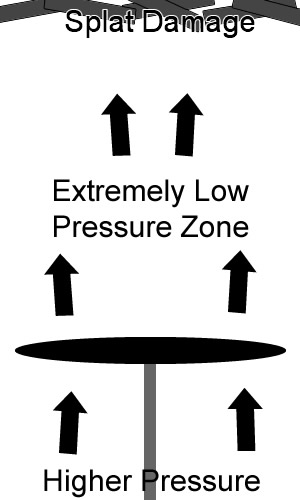
The other big violation is that Freeman takes no damage from flying into the ceiling when really he ought to take more damage from hitting his head than his feet. There�s no obvious deceleration to explain this, either. There are a few ways the designers might have achieved this, and I probably won�t cover them all. I want to point out a few things relevant to the design, however.
The first option is a global rule: Freeman�s head takes no fall damage. This would mean that the fall damage calculation is separate from the collision/impact calculation of bullets and moving objects. That would probably present a host of bugs during other types of collisions, so I�m guessing that isn�t it. Another option would mean that fall damage only occurs with a downward vector, and isn�t based on speed at all. This would mean that the �Freeman� object has a counter variable in it that measures the uninterrupted changes in Y-axis position and calculates damage based strictly on negative changes in position. This option makes the most sense with what we know of Xen. In Xen, the fall damage scales bizarrely, such that jumps that seem safe are often fatal. The designers probably put in a �sudden death� limit or special multiplier on Y-axis position changes in Xen to make their set pieces work. The final option is that there is a unique �no damage� modifier at the top of this shaft. This would actually be the simplest option, and it would work just fine for Half-Life because, one, there are no sources of damage at the top of the shaft, and two, there are no other examples of this kind of flight in the game.
That last technique for eliminating damage from ceiling collisions is a good meta-example of what all of these strategies are doing. Defying the real-world rules of physics is fine in a videogame; it often makes the game a lot more fun in the case of a platformer. This is what has been called (in videogames and elsewhere) acceptable breaks from reality. The best way to employ an acceptable break from reality is to leave in the obvious and intuitive portion of a mechanic (like a fan causing Freeman to fly) but to take out the deadly minutiae like pressure gradients and collision damage. The last example I listed above, in which there is a special �no damage� zone at the top of the fan shaft, is an in-universe example of an acceptable break from reality. If that is the mechanical trick that the designers employed, it is an example of the designer cancelling the rules of the Half-Life universe the same way that Half-Life cancels many of the real universe�s rules (like, say, the ability to instantly regenerate health) for the sake of gameplay.
Smaller Flourishes
There are some less-grandiose flourishes in the game, too, that help to reinforce the persuasiveness of the game world and help to keep giving the player surprises. One of these surprises is the ceiling-mounted laboratory gun in chapter 11.
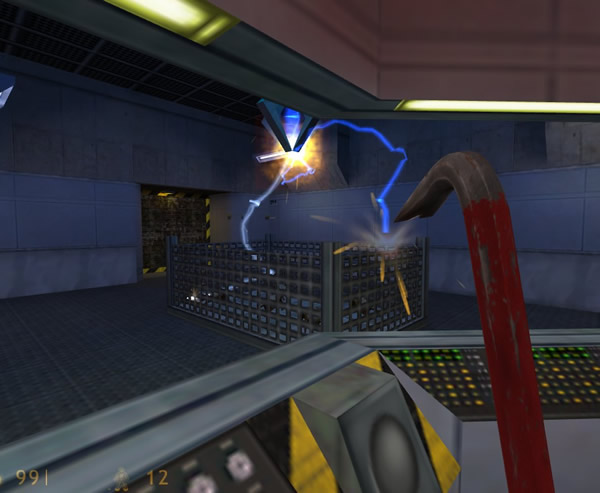
This weapon seems like a great idea: it�s different, and it�s located in a point in the game where the player has very little ammo. The problem is that the AI does not cooperate with the player�s desire to nuke a room full of enemies. Luring the Headcrabs out of the cages or pulling guards in from the hallway�both of these tasks are clumsy. Half-Life is many things, but it is not clumsy. The precision and finesse of Half-Life were light years ahead of what else existed in mainstream PC games at the time.
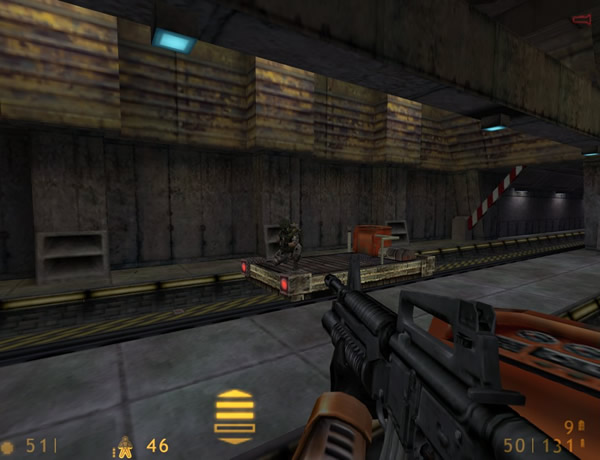
Killer Rabbits
There are a handful of moments in Half-Life in which the player is suddenly killed by a lone enemy or sudden, unexpected fall. I am on record as saying I don�t like this as it has little to do with the primary skills of the game like reading cover, reacting to an arena dynamic or jumping precisely. There are games that are about unthinking reactions to sudden stimuli, and Half-Life is not one of them. The best example I can think of is in chapter 8, when a soldier down a long hallway launches a rocket at Freeman�s cart.
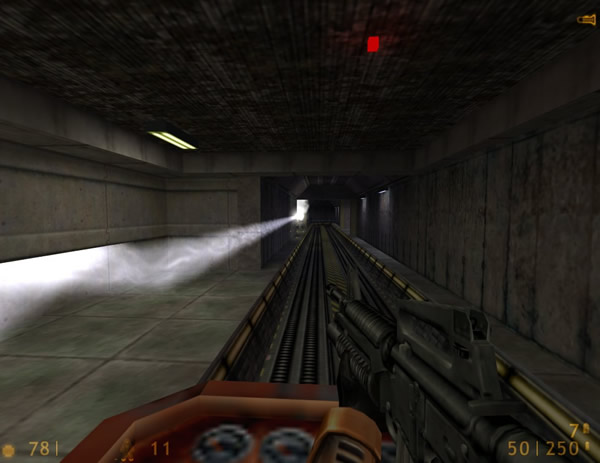
The hallway is narrow, the soldier is hard to see, and the blast is fatal. Why does this need to be in the game? There�s no cover, there�s no arena, there�s no platform and there�s no warning sign. All of the organization and thoughtfulness that are packed into Half-Life are absent in this instance. Another example, although it is less egregious, is the minefield.
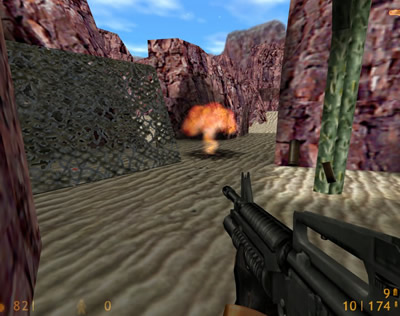
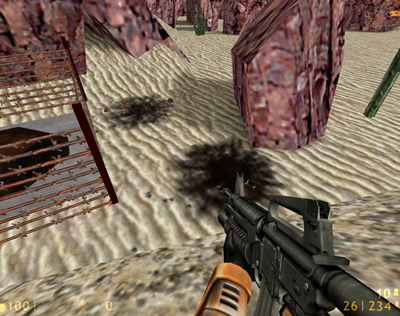
Where does randomly dying in one brutal moment fit into the design scheme of this game? There are plenty of games like that, but Half-Life is not one of them. Even if the player can shoot the mines to reveal them, how does wasting tons of ammo make sense in the context of this game? This is just needless. This kind of cheap death would be the same as if one of the level-zero rabbits in a World of Warcraft starting zone suddenly killed the player.
The design team did a better job with this idea when they implemented the sniper nest. Several instances of the sniper nest appear late in the game in unexpected spots, yet manage to not be totally unfair. You can see here how the sniper nests are unobtrusive in their high locations, but the solution to them is obvious.
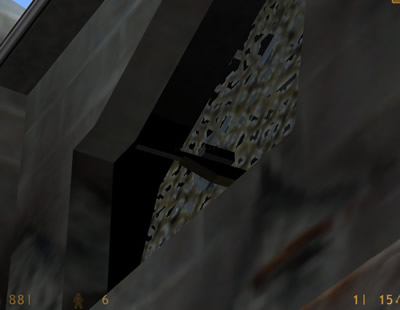
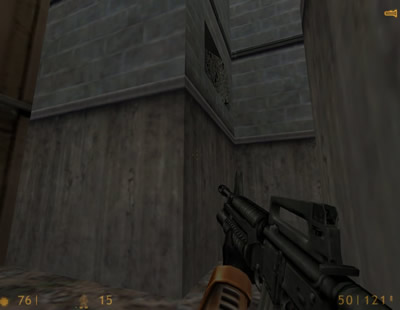
The biggest mitigating factor built into these nests is that they�re not instantly fatal. Taking cover is possible; fighting back is possible. The player has options and can use them, and so if Freeman suffers fatal damage, the player is more likely to feel that the death was his or her own fault. It�s never good when the player thinks, �the designers are just being jerks here.� Instant deaths cause this frustration, but these sniper nests do not.
Ranger Danger
Although it does not seem that the designers of Half-Life were determined to make it so, the game has very few instances of long-range combat. This avoidance may have to do with the design of the game's weapons. Up until the generation of FPS games to which Half-Life belongs, projectile weapons in games fired large bullets in perfectly straight lines. In Half-Life, there is an element of semi-realistic weapon jitter, and the bullets are quite small compared to past shooters. Quake had introduced 3D enemy models with accurate hitboxes, and Half-Life preserves that trait. All of these features make long-range combat difficult unless the player is using a specialized weapon. Half-Life really only has one weapon that is "made" for long range: the crossbow. The level of specialization is a little lacking, however, as the accuracy made possible by the zoom function is confounded by a slow-moving projectile. The maximum distance at which the crossbow is really useful is the distance we see in chapter 9.
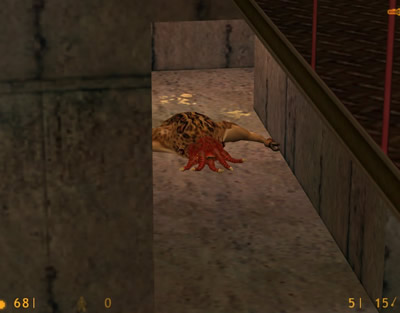
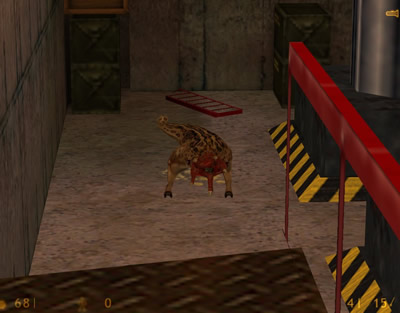
(It�s hard to tell from the screenshots, but both of these examples are shot in the zoomed-in view.) Having just received the crossbow, it makes sense that the designers would allow the player to use it at its most pertinent range and purpose. What's really interesting is that the Bullsquid has been used like this before, several times before the player gets the crossbow. The majority of these earlier instances are in chapter 6.
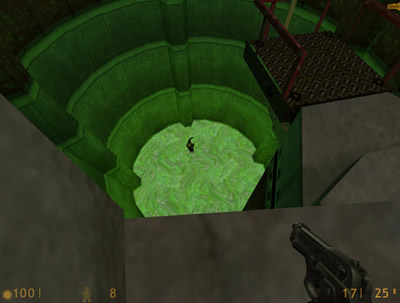
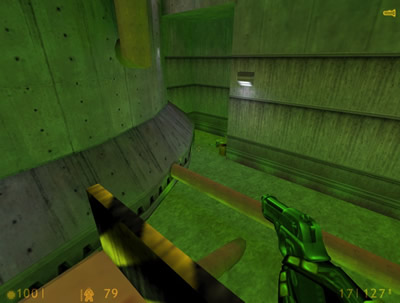
In these cases, there's actually not much reason to kill the Bullsquid. It doesn't guard anything terribly useful, and there's plenty of cover to shield Freeman from the flying gobs of acid.
The cover and the slow speed of the acid are the point, I think. Most of the projectile weapons in the game hit their target instantly. Explosive weapons don�t do this, but they�re so dangerous that to strike instantly would be unfair. Of the non-explosive weapons that enemies possess (at least before arriving in Xen), only the hive-hand weapon doesn�t strike right after it�s fired, but it does fire homing missiles. The long range at which the player engages these Bullsquids gives enough time to dodge the projectiles. The fact that many of these Bullsquids are in completely inaccessible or totally unimportant locations means that the player doesn�t need to engage them. Contrast this with the last three set pieces in chapter 17; in those set pieces the player has to fight the alien overseer at long range. Like the Bullsquid, the overseer fires a slow-moving projectile. Unlike the Bullsquid, the player must defeat the overseers in order to survive the trip to the top of the factory in chapter 17. It makes sense, in theory, that the overseer serves as an evolved (flying) form of the Bullsquid in later chapters, but both evolving the monster and changing its context proves to be too much.
Introductory Content
I have always found the praise and defense of Half-Life's first chapter to be a bizarre artifact of nostalgia. This introduction is one of the most boring parts of any videogame I have ever played. The introduction to Skyrim, which is another captive ride through a non-interactive environment, lasts a fraction of the time that the Half-Life intro does, and yet it was almost universally panned. Obviously, Half-Life�s introductory chapter doesn't affect the quality of the game overall, and everyone who plays Half-Life will probably ignore the initial boredom based on the strength of Half-Life's reputation. But I do find it curious how almost none of the places seen on this trip through Black Mesa ever appear again in the game.
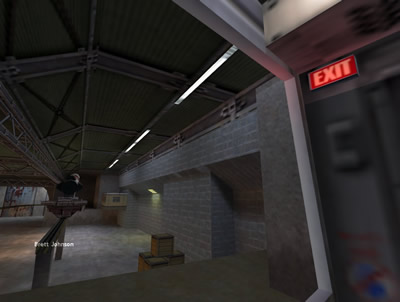
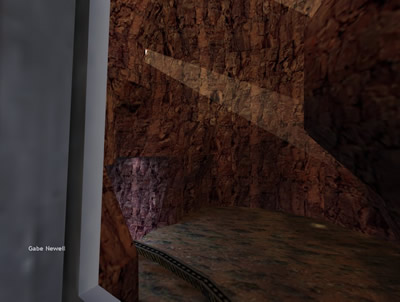
Not only would revisiting some of these places give the game a wonderful sense of artistic symmetry, but it would also save a lot of time in level design, as those rooms could be re-used, even if they had to be copied and pasted into both levels. For whatever reason, this did not happen. Chapter 2, by contrast, is more defensible. Plenty of RPGs and adventure games begin in a town or town-like area with only minimal action. Some of those towns are more interesting than others, but a period of well-crafted exploration in a persuasive environment is a time-honored technique, and I think that chapter 2 of Half-Life manages to pull it off well.
In chapter 3, we get to the real meat of the introductory content. Because the designers did such a good job dividing the game into segments of increasing complexity, the introductory content for Half-Life is very simple and straightforward. It's also quite cleverly designed in the way it manages to pack in so many lessons into small pieces of through content. After escaping the lab, the first thing the player sees in terms of enemies is a couple of captive Headcrabs. These leap menacingly at the player, but cannot escape their glass tubes.
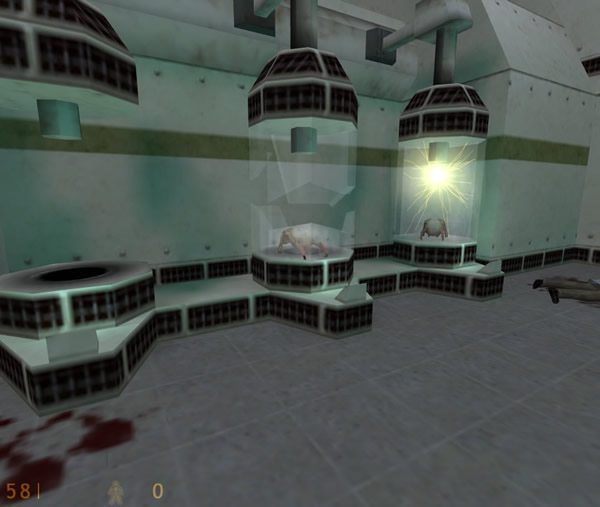
Just after this, there's a mandatory NPC follower that Freeman has to lead to the retinal scan. The absence of enemies is the perfect way of having a no-penalty task to teach the player about NPC behaviors. Following that is a dangerous beam that toggles on and off, but which is almost harder to cross than it is to avoid.
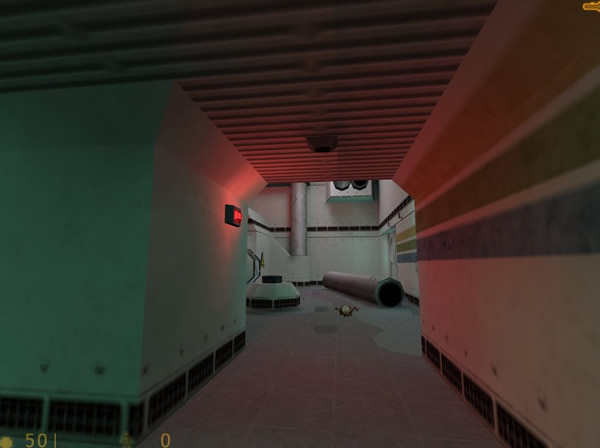
And after that, the player faces the first enemy: a lone Headcrab. Following that encounter, the player encounters an evolved form of the toggling beam in the form of lasers.
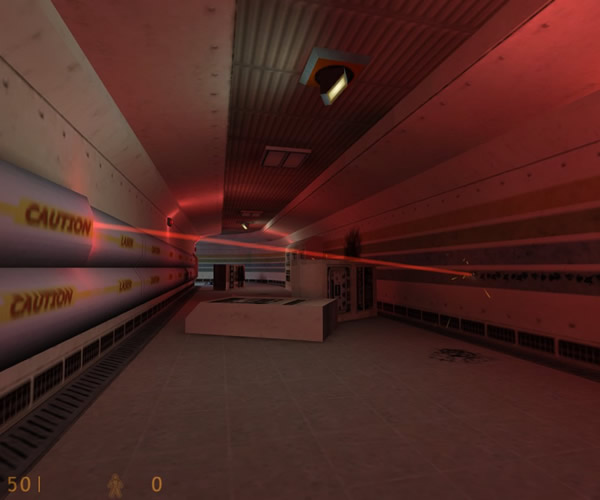
The cluttered ground and odd angles of the beams make for a good exercise in ducking, jumping and strafing. My favorite part of this whole section is the placement of the crowbar.
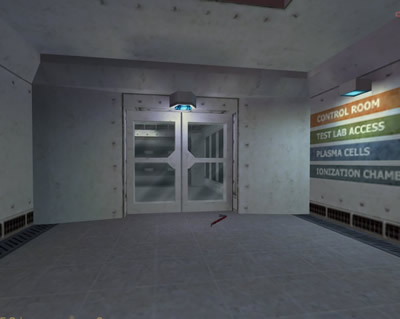
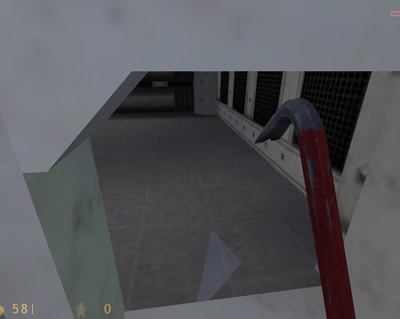
The crowbar, merely by its placement, tells the player that it's possible to break the glass and duck through. This is an old technique, to be sure, but its execution here is elegant. While the crowbar is highly conventional (if very well done), the introduction to Headcrab zombies and the guard NPC is unconventional.
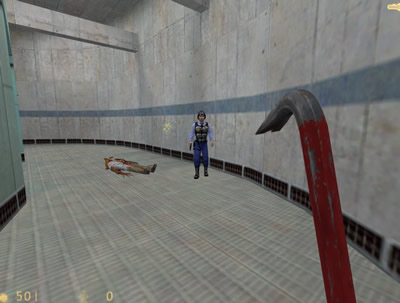
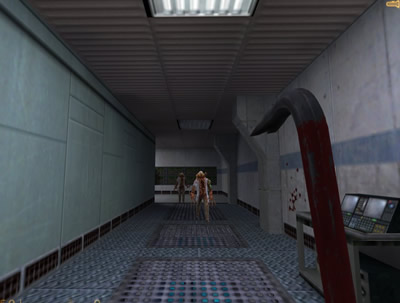
An NPC with this level of agency and power was very uncommon back in 1998. The fact that the designers introduced the zombies and the guard's abilities at the same time is both unusual and efficient. This is reiterated later with the guard shooting two Zombies, though doesn't teach the player anything except that it's a good idea to not panic. The zombies are slow, and bullets will (eventually) work. Shortly after this, Freeman collects his own gun.
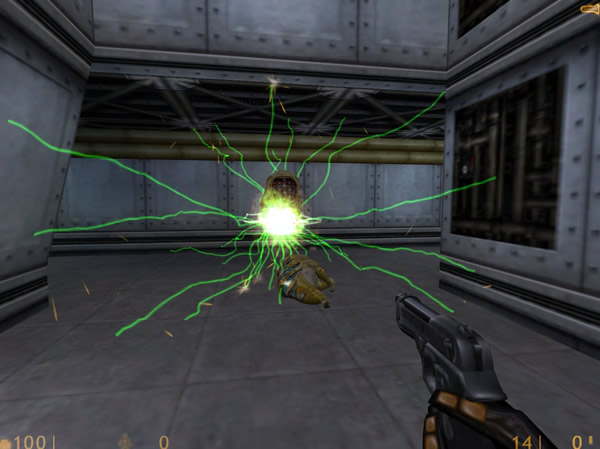
Even with teleports, the enemies that appear after acquiring the gun are all easy, and appear directly in front of Freeman at all times. There's only one real threat: the Vortigaunt in the doorway just beyond this point. Being in that doorway means that the Vortigaunt doesn't have a great angle of fire, however, and the player can get Freeman out of sight quite easily. The final piece of truly "introductory" material is this teleport after the first set piece.
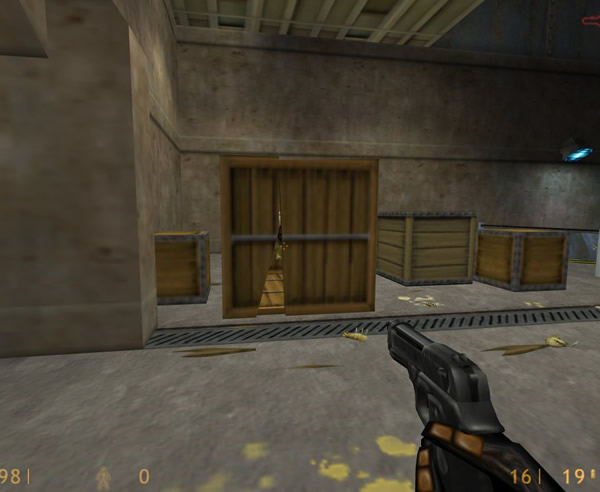
Although this is not the first teleport, it's the first teleport to actually behave like a monster closet in that it doesn't appear directly in front of Freeman's path. The Houndeye falls into the box however, meaning that this is a minimally dangerous way to introduce to the player the concept of out-of-sight teleports, which will be a frequent component of the game. Like everything else in the introductory section, it's a greatly softened version of normal content.
The Arena Theme - Back | Next - Seven Lessons from Half-Life